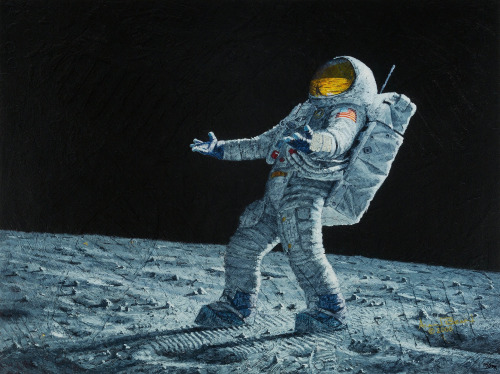Latest Posts by epic-flight - Page 8


August 20, 2001 – Beautiful views of the International Space Station, observed from the Space Shuttle Discovery after the spacecraft undocked from the orbital outpost. (NASA)

John Berkey cover art for The Best of Frederik Pohl, 1975.

The Avalon - Passengers

Clouds swirling in the coffee colored atmosphere of Jupiter, looks more like a familiar morning beverage of champions.
This image from our Juno spacecraft was captured in North North Temperate Belt. Image Credit: Enhanced Image by Gerald Eichstädt and Sean Doran (CC BY-NC-SA)/NASA/JPL-Caltech/SwRI/MSSS
Make sure to follow us on Tumblr for your regular dose of space: http://nasa.tumblr.com
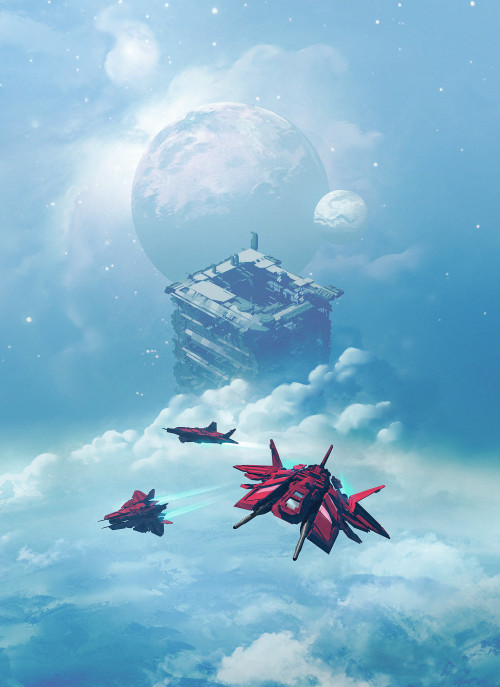
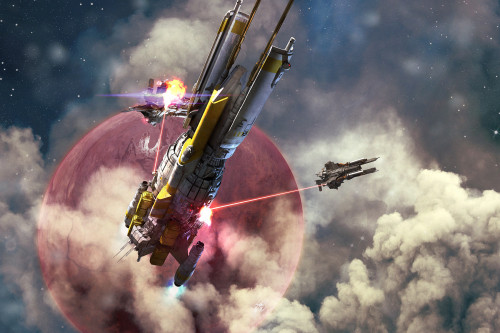
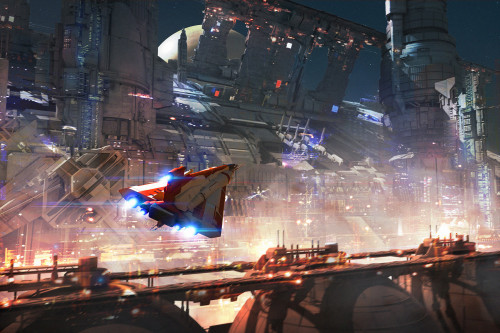

Sci-fi art by Isaac Hannaford.

Dark Spot and Jovian ‘Galaxy’ - This enhanced-color image of a mysterious dark spot on Jupiter seems to reveal a Jovian “galaxy” of swirling storms. Juno acquired this JunoCam image on Feb. 2, 2017, at an altitude of 9,000 miles (14,500 kilometers) above the giant planet’s cloud tops. This publicly selected target was simply titled “Dark Spot.” In ground-based images it was difficult to tell that it is a dark storm. Citizen scientist Roman Tkachenko enhanced the color to bring out the rich detail in the storm and surrounding clouds. Just south of the dark storm is a bright, oval-shaped storm with high, bright, white clouds, reminiscent of a swirling galaxy. As a final touch, he rotated the image 90 degrees, turning the picture into a work of art.
Credits: NASA/JPL-Caltech/SwRI/MSSS/Roman Tkachenko

Jupiter grom Ganymede - Vadim Sadovski
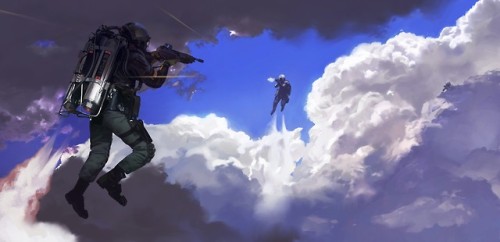

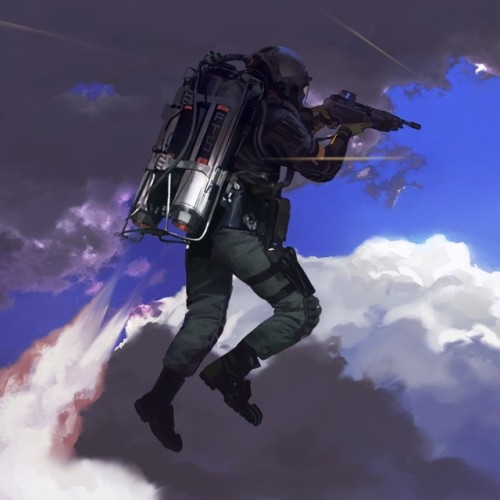
Jet pack - Faraz Shanyar

Me irl


”I didn’t feel like a giant. I felt very, very small.”
–Neil Armstrong on looking back at the Earth from the Moon in July 1969.
(Sources: 1, 2)

Inner Depth.
You can get this GIF as a phone wallpaper for free through the Zedge app.
You can also get this GIF as a looping 1080p video if you support me on Patreon.
Twitter / Instagram / Shop / Patreon / Zedge

Design graphics Geya Shvecova (Smoky_MOON_171219)

Apollo 11 astronaut Neil Armstrong loads rocks into the lunar module, as painted by Apollo 12 moonwalker Alan Bean in 1985.

Apollo 11 astronaut Buzz Aldrin on the surface of the Moon, photographed by Neil Armstrong, July 1969. (LIFE)

“First Men on The Moon” by Robert McCall, 1971.

The first step on the Moon, illustrated by Norman Rockwell for Look, 1967.

March 16, 1966 – Astronaut Neil Armstrong in the Gemini 8 spacecraft, making final adjustments and checks during the prelaunch countdown. (NASA)

meirl
The Lives, Times, and Deaths of Stars
Who among us doesn’t covertly read tabloid headlines when we pass them by? But if you’re really looking for a dramatic story, you might want to redirect your attention from Hollywood’s stars to the real thing. From birth to death, these burning spheres of gas experience some of the most extreme conditions our cosmos has to offer.

All stars are born in clouds of dust and gas like the Pillars of Creation in the Eagle Nebula pictured below. In these stellar nurseries, clumps of gas form, pulling in more and more mass as time passes. As they grow, these clumps start to spin and heat up. Once they get heavy and hot enough (like, 27 million degrees Fahrenheit or 15 million degrees Celsius), nuclear fusion starts in their cores. This process occurs when protons, the nuclei of hydrogen atoms, squish together to form helium nuclei. This releases a lot of energy, which heats the star and pushes against the force of its gravity. A star is born.

Credit: NASA, ESA and the Hubble Heritage Team (STScI/AURA)
From then on, stars’ life cycles depend on how much mass they have. Scientists typically divide them into two broad categories: low-mass and high-mass stars. (Technically, there’s an intermediate-mass category, but we’ll stick with these two to keep it straightforward!)
Low-mass stars

A low-mass star has a mass eight times the Sun’s or less and can burn steadily for billions of years. As it reaches the end of its life, its core runs out of hydrogen to convert into helium. Because the energy produced by fusion is the only force fighting gravity’s tendency to pull matter together, the core starts to collapse. But squeezing the core also increases its temperature and pressure, so much so that its helium starts to fuse into carbon, which also releases energy. The core rebounds a little, but the star’s atmosphere expands a lot, eventually turning into a red giant star and destroying any nearby planets. (Don’t worry, though, this is several billion years away for our Sun!)

Red giants become unstable and begin pulsating, periodically inflating and ejecting some of their atmospheres. Eventually, all of the star’s outer layers blow away, creating an expanding cloud of dust and gas misleadingly called a planetary nebula. (There are no planets involved.)

Credit: NASA, ESA, and the Hubble Heritage Team (STScI/AURA)
All that’s left of the star is its core, now called a white dwarf, a roughly Earth-sized stellar cinder that gradually cools over billions of years. If you could scoop up a teaspoon of its material, it would weigh more than a pickup truck. (Scientists recently found a potential planet closely orbiting a white dwarf. It somehow managed to survive the star’s chaotic, destructive history!)

High-mass stars
A high-mass star has a mass eight times the Sun’s or more and may only live for millions of years. (Rigel, a blue supergiant in the constellation Orion, pictured below, is 18 times the Sun’s mass.)

Credit: Rogelio Bernal Andreo
A high-mass star starts out doing the same things as a low-mass star, but it doesn’t stop at fusing helium into carbon. When the core runs out of helium, it shrinks, heats up, and starts converting its carbon into neon, which releases energy. Later, the core fuses the neon it produced into oxygen. Then, as the neon runs out, the core converts oxygen into silicon. Finally, this silicon fuses into iron. These processes produce energy that keeps the core from collapsing, but each new fuel buys it less and less time. By the point silicon fuses into iron, the star runs out of fuel in a matter of days. The next step would be fusing iron into some heavier element, but doing requires energy instead of releasing it.
The star’s iron core collapses until forces between the nuclei push the brakes, and then it rebounds back to its original size. This change creates a shock wave that travels through the star’s outer layers. The result is a huge explosion called a supernova.

What’s left behind depends on the star’s initial mass. Remember, a high-mass star is anything with a mass more than eight times the Sun’s — which is a huge range! A star on the lower end of this spectrum leaves behind a city-size, superdense neutron star. (Some of these weird objects can spin faster than blender blades and have powerful magnetic fields. A teaspoon of their material would weigh as much as a mountain.)

At even higher masses, the star’s core turns into a black hole, one of the most bizarre cosmic objects out there. Black holes have such strong gravity that light can’t escape them. If you tried to get a teaspoon of material to weigh, you wouldn’t get it back once it crossed the event horizon — unless it could travel faster than the speed of light, and we don’t know of anything that can! (We’re a long way from visiting a black hole, but if you ever find yourself near one, there are some important safety considerations you should keep in mind.)

The explosion also leaves behind a cloud of debris called a supernova remnant. These and planetary nebulae from low-mass stars are the sources of many of the elements we find on Earth. Their dust and gas will one day become a part of other stars, starting the whole process over again.
That’s a very brief summary of the lives, times, and deaths of stars. (Remember, there’s that whole intermediate-mass category we glossed over!) To keep up with the most recent stellar news, follow NASA Universe on Twitter and Facebook.
Make sure to follow us on Tumblr for your regular dose of space: http://nasa.tumblr.com.

A Colorful Moon The Moon is normally seen in subtle shades of grey or yellow. But small, measurable color differences have been greatly exaggerated to make this telescopic, multicolored, moonscape captured during the Moon’s full phase. The different colors are recognized to correspond to real differences in the chemical makeup of the lunar surface. Blue hues reveal titanium rich areas while orange and purple colors show regions relatively poor in titanium and iron. The familiar Sea of Tranquility, or Mare Tranquillitatis, is the blue area in the upper right corner of the frame. White lines radiate across the orange-hued southern lunar highlands from 85 kilometer wide ray crater Tycho at bottom left. Above it, darker rays from crater Copernicus extend into the Sea of Rains (Mare Imbrium) at the upper left. Calibrated by rock samples from the Apollo missions, similar multicolor images from spacecraft have been used to explore the Moon’s global surface composition. Image Credit & Copyright: László Francsics
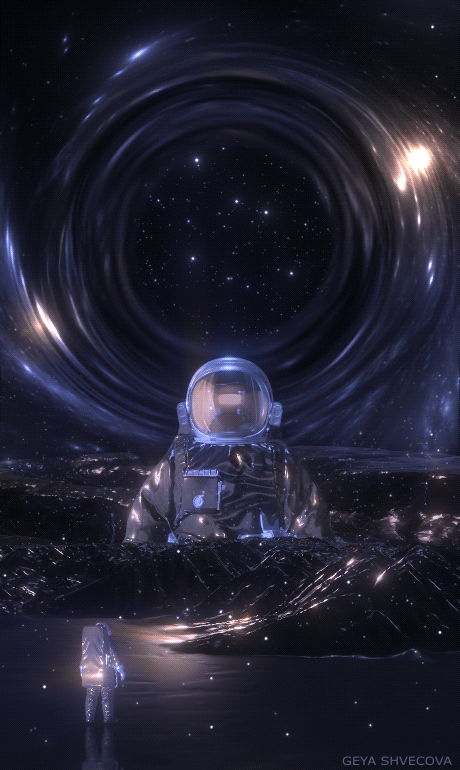


Design graphics Geya Shvecova (Jump into the void) Archive_020920

